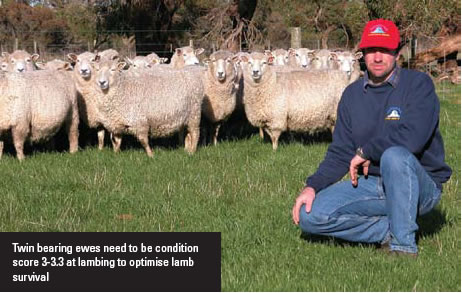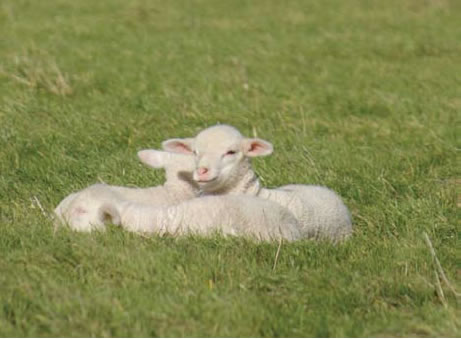|
|
Background
information
Poor survival of newborn lambs is a major source of lost productivity in breeding enterprises where lambing percentages of 110–130% born can result in a marking percentage of 70–90%. Most of these losses are associated with poor nutrition during pregnancy. By contrast, the number of ewes that fail to get in-lamb is normally less than 10% of the mob.
Ewes that are pregnant and lactating produce about 20% less wool than a dry ewe. Ewes that lose a lamb at birth produce about 10% less wool than a dry ewe. This is in addition to the economic loss of the lamb.
|
|
 |
 |
Management of ewe nutrition during pregnancy increases lamb birth weight and survival.
|
 |
Ewes in condition score 3 at lambing are likely to wean more lambs.
|
 |
Manage twin-bearing ewes to be at least condition score 3 at lambing.
|
 |
There is considerable economic loss when ewes get pregnant but fail to rear a lamb. |
|
 |
Introduction
Important management aspects of nutrition in the pregnant ewe include:
- At about 40 days after conception the placenta begins to grow and continues its rapid growth until about day 95. This is followed by accelerated foetal development from day 90 through to lambing at around day 150.
- Good nutrition in late pregnancy can overcome poor nutrition in early pregnancy. A condition score change in ewes up to day 90 of pregnancy will change lamb birth weight by 0.3 kg and a condition score change after day 90 will change birth weight by 0.5 kg.
- The placenta and foetus represent a considerable mass in late pregnancy and feed quality needs to be high to enable sufficient intake of nutrients. This is particularly the case in the last two weeks of pregnancy.
- In normal seasons, spring lambing flocks require few additional nutrients through joining and early pregnancy until 100 days after the start of joining.
- Ewes can lose a small amount of weight (0.3 of condition score) if green pasture can be accumulated for grazing and weight gain in late pregnancy.
- When pasture conditions do not enable gains in late pregnancy, it is most profitable to maintain condition throughout pregnancy.
- Aim to keep ewe condition around score 3 in autumn lambing flocks.
- Supplementary feeding grain to day 100 of pregnancy to increase lamb survival has few economic benefits.
- Improving ewe nutrition during late pregnancy will normally increase birth weight and lamb survival, increase wool production in ewes but also increase fibre diameter.
- The birth weight of a lamb is determined by the following factors: sex, litter size, placental development, ewe condition, genetics, length of gestation and the timing, quality and quantity of pasture during pregnancy.
- Optimum birth weight for lamb survival is between 4.5 and 5.5 kg. Survival decreases sharply if lambs weigh less than 4 kg or more than 6kg at birth.
- Recent research has shown that potential lifetime wool production of the progeny can be compromised by poor ewe nutrition during mid and late pregnancy. A 10kg drop in liveweight between joining and day 90 reduced progeny fleece weight by 190g and increased fibre diameter by about 0.3 micron. The effects of changes in ewe liveweight during late pregnancy were similar. The effects from both periods are cumulative.
- If ewes lose condition in early pregnancy and gain condition in late pregnancy, the effects are similar to maintaining condition throughout pregnancy. During pregnancy, foetal losses are relatively small. Toxicities that cause death of the foetus and infectious abortions can occur in some situations (see procedure 11.4 in Healthy and Contented Sheep).
The challenge for management is to adopt strategies that are cost effective and wean more lambs.
Key decisions, critical actions and benchmarks
Managing ewes during pregnancy
The most favourable nutritional strategy during pregnancy has the following key features (see tool 10.4):
- Ewes can manage a fall from condition score 3 at joining to condition score 2.7 at day 90 of pregnancy where quality pasture is available to allow a gain in weight back to condition score 3 for late pregnancy. Otherwise, maintain condition throughout pregnancy.
- Ewe condition score needs to be at least score 3 at lambing to minimise mortality and optimise wool and meat production of progeny (tool 10.4).
- Single bearing ewes can be too fat at lambing and their condition should not exceed score 4. Twin bearing ewes are rarely at risk of being too fat due to higher nutritional demand.
- When condition score cannot be increased by grazing management in late pregnancy, it is most profitable to maintain condition throughout pregnancy. If the ewes lose weight, supplementary feed.
- The least cost option to meeting condition score targets is to match the breeding cycle with pasture availability (see procedure 8.3 in Turn Pasture into Product).
- In dry or drought years when the cost of supplementary feeding is very high, consider allowing ewes to fall to condition score 2.5, but feed to maintain ewe conditionin late pregnancy whatever the season (see procedure 11.5 in Healthy and Contented Sheep).
- Supplementary feeding in late pregnancy to increase liveweight is unlikely to be of economic benefit. It can cause an increase in lamb birth weight to the point where dystocia (difficult births) may become a problem.
- A tactic may be to increase the pasture quantity available for late pregnancy by deferred grazing in early pregnancy.
- Abortions and pasture toxicoses (such as vibrio abortion, onion weed and perennial rye grass toxicosis) occasionally cause major losses during pregnancy and at full term. Investigate any abnormal losses with your animal health adviser.
As a guide for spring lambing flocks on mixed perennial pastures:
- Single bearing ewes need Feed On Offer (FOO) of 700–900 kg green dry matter (DM)/ha and twin lambing ewes a FOO of 1,000–1,200 kg green DM/ha during mid-pregnancy. Note: Feed on Offer (FOO) is a measure of total pasture available to ground level.
- On annual clover based pastures manage lambing paddocks to achieve a minimum FOO of 1,200 kg green DM/ha at the start of lambing. A FOO of 1,500 kg green DM/ha is recommended for single bearing ewes.
- Twin bearing ewes need FOO of 1,800 kg green DM/ha on annual cloverbased pastures.
- Aim to have identified twin bearing ewes in condition score 3–3.3 at lambing to optimise survival.
- Use the pasture assessment tools in tool 7.6 in Grow More Pasture, PROGRAZE® courses and Lifetime Wool manuals.
For information on clostridial diseases and parasite control during pregnancy see procedures 11.2 and 11.3 in Healthy and Contented Sheep.
Pregnancy scanning ewes

The decision to pregnancy scan ewes, either for wet/dry or multiples is an important one and benefits vary with season, the reproductive rate of the flock, the management of the scanned ewes and whether their number will affect the overall flock structure. Tool 10.7 looks at the pros and cons of pregnancy scanning as a routine management practice.
Timing of routine husbandry practices
As a general rule:
-
Shearing ewes pre-lambing increases ewe feed requirements by 25–30% when shearing coincides with cold winter weather.
-
Being held off-pasture for shearing results in weight loss in ewes and possibly higher supplementary feed requirements, especially in poor pasture growth seasons.
- If shearing happens to coincide with wet weather there is also greater risk of metabolic problems and pregnancy toxaemia. Ewes in condition score 3 are more able to withstand the effects of cold weather after shearing.
- Crutching within four weeks of lambing is not as risky as shearing, as ewes are less likely to be held off-pasture for extended periods.
- Carry out 6-in-1 vaccination of ewes between 2-6 weeks before lambing.
- In areas where ewes require a pre-lambing drench, make it close to lambing to gain the benefit.
- Trace element treatments may be given at this time or at shearing or crutching, but this should be discussed with your animal health adviser.
- Controlling fox predation is vitally important especially in twinning paddocks. Undertake fox control procedures before lambing commences. See tool 5.11 in Protect Your Farm’s Natural Assets.
In the last 4 to 6 weeks of pregnancy there is a greater risk of toxaemia or metabolic syndromes such as hypocalcaemia. This can be off-set by managing routine procedures to minimise stress on ewes. Refer to procedure 11.5 in Healthy and Contented Sheep and consult your animal health adviser for further information.
Signposts  |
Read
Lifetimewool Ewe Management Handbooks for your region Available from www.lifetimewool.com.au
Lifetime Wool Regional Guidelines - a series of guidelines and recommendations for managing ewe flocks throughout the year. Visit the Lifetime Wool website: www.lifetimewool.com.au/guidelines.aspx
Attend
Lifetime Ewe Management – the workshop focuses on the health issues associated with the Merino ewe and develops sheep producers’ skills in sheep assessment and feed budgeting. Contact the Rural Industries Skill Training (RIST) centre on:
Apps
Lifetime Ewe Management: available for iOS and Android. Based on LTEM course. Requires knowledge of condition scoring and feed on offer to use and assists in feed budgeting.
Lambing Planner: available for iOS and Android. The lambing Planner allows you to input lambing or joining dates to see the impact on other key management dates in the reproductive year. It also features a short best practice guide for lambing.
|

|